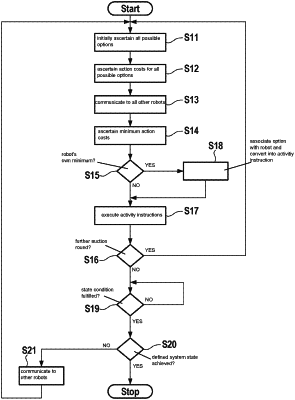| CPC B25J 9/1682 (2013.01) [B25J 9/163 (2013.01); G05B 19/41815 (2013.01); G05B 2219/32328 (2013.01)] | 8 Claims |

|
1. A method for operating a multi-agent system including multiple robots, in which a predefined mission that is defined by a sequence of a plurality of system states is to be executed, wherein the plurality of system states include an initial system state and a target system state that is attainable alternatively by use of any of a plurality of state sequences that are each formed of a respective one or more intermediate system states between the initial state and the target system state, each robot of the robots cyclically carrying out the following steps:
carrying out an auction process having one or multiple auction rounds, the following steps being carried out in each active one of the auction rounds:
starting from a considered one of the plurality of system states, ascertaining a plurality of possible options, the possible options each defining a respective action via which a transition from the considered system state to a respective successor state may be achieved, the respective successor state being either one of the intermediate system states immediately following the considered system state or the target system state immediately following the considered system state, wherein, for one or more of the auction rounds, different ones of the plurality of possible options are to different ones of the intermediate system states and different ones of the plurality of possible options are to a same one of the intermediate system states using different actions;
for each possible option of the plurality of possible options, ascertaining a total action cost for the respective robot to carry out the action that is defined by the possible option;
providing to the other robots the total ascertained action cost for each of the possible options, and receiving from the other robots total action costs for each of the possible options;
carrying out an auction by, for each of the plurality of possible options of the auction round, comparing all of the total action costs of the respective robot and of the other robots, wherein the respective robot assigns to itself the respective possible option when and conditional upon that a result of the comparison is that a lowest of all of the total action costs of the respective option is the total action cost ascertained for the respective robot to carry out the action defined by the respective possible option, wherein the action costs of the possible options of the presently active one of the rounds are ascertained taking into account estimated mission costs that are based on (a) where the presently active one of the rounds is not a first one of the rounds of the auction process, costs ascertained in one or more previously carried out rounds of the auction process for achieving the currently considered one of the system states, (b) empirical costs that indicate estimated costs for achieving the target state of the mission, starting from a successor state that is achievable via the considered option, (c) costs for carrying out the considered option, and (d) a transition probability that the mission utilizes the considered option; and
determining whether to carry out another of the one or multiple rounds in which the successor states are used as the considered system state or to instead terminate the auction process according to a condition that (I) the another of the one or multiple rounds is to be carried out without performance of the actions of the assigned options of the currently active one of the rounds if both (a) not all of the robots have been assigned one of the options of the auction process and (b) the target state has not been reached as any of the successor states and (II) the auction process is otherwise terminated; and
responsive to the termination of the auction process, beginning an execution of those of the actions of the options that the respective robot has assigned to itself during the auction process.
|